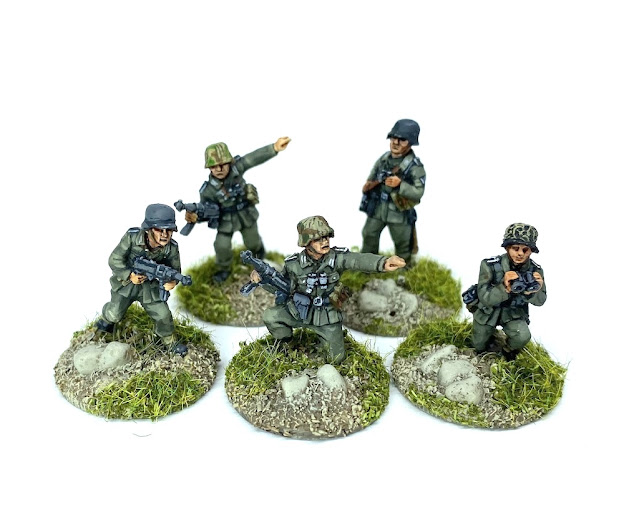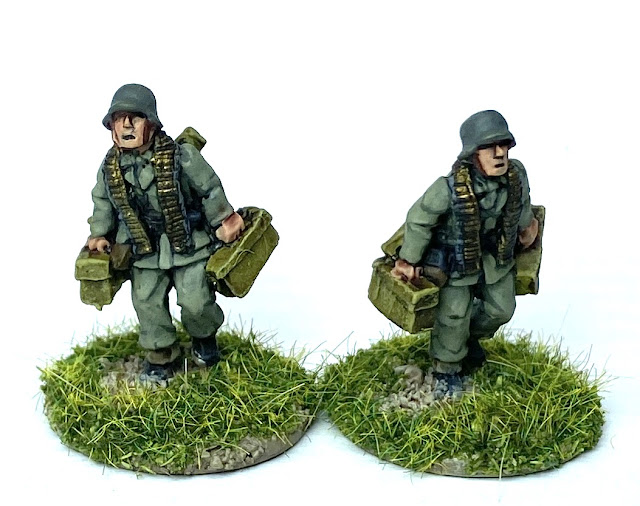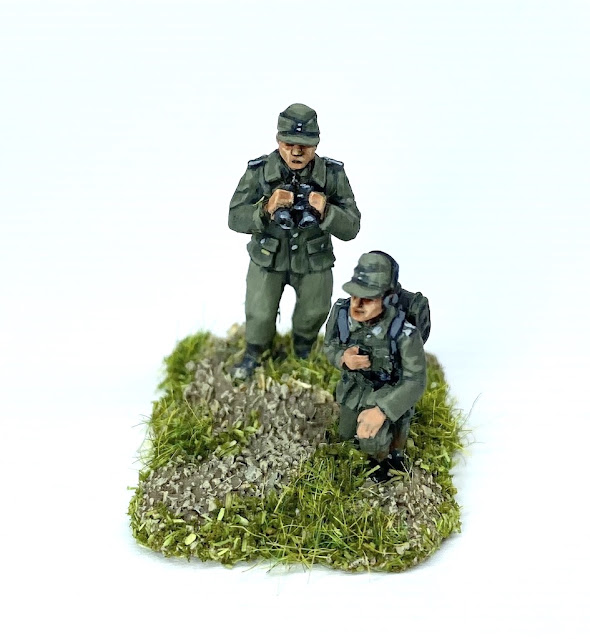The choice when it comes to what Second World War German force to build must be one of the widest there is in the hobby. As with my British I originally built my German platoon using the 1/72 Plastic Soldier Company set and as those figures cover the later war (1943-45) that's been the main focus for my collection. Over time, as I've done with my British, I have slowly moved over to using metal miniatures and once again mainly those from AB Figures. Nonetheless the main focus has been on those later years of the war.
So of course the big question is, what is the best colour for Feldgrau uniforms? It's a topic that can be hotly debated but always comes back to the image below, which tends to stop all discussion in its tracks.
As I said, my platoons are all for the mid to late stages of the war, although at a stretch they would be suitable for 1942 in places like Stalingrad. My late-war Heer platoon for Chain of Command that I'm showing here, is based on the lists in the second edition rule book.
 |
| Copyright TooFatLardies |
The platoon HQ is composed of a solitary Unterfeldwebel, a senior leader. As usual my senior leaders are on rectangular bases and these three are all from AB Figures.
The Obergefreiters, the
junior leaders for each of the platoon's squads, are on 20mm rounds, the same as the riflemen. They are distinguished by their weaponry (usually a machine pistol); their leader-like pose and a few large rocks on their base. Once again these are all from AB.
The different types of bases help to distinguish the senior from the junior leaders.
Depending on the period of the war the squad leaders will have a number of panzerfaust available for the squad to fire. While it is not necessary to represent these on the table, I find it useful to exchange a figure armed with a panzerfaust with one of the rifleman, as a reminder the squad has one to fire. Once it has been fired, then the figure is swapped out again and the rifleman returned.
Despite the fact millions were produced during the war I haven't seen many panzerfaust on display in museums. Here is one I've seen on display in the Canadian War Museum.
Each squad in the 1944 platoon is made up of five riflemen and a four man LMG team, led by the Obergefreiter (junior leader). Three of these squads make up the standard infantry platoon for the mid to late war period.
The MG42 teams have the main gunner and the loader on the same base. I do this with most of my weapons teams as it makes them easy to identify on the table. As you can see in the case of the kneeling machine gun team in the picture below, they often work well posed together.
The third and fourth member of the team are based like riflemen and will be the first to be removed in the case of a casualty.
It seems you can never have enough German LMG teams, particularly if you intend to field a panzergrenadier platoon, in which case you will need two LMG teams per squad. Given the possibility that a fourth squad can be added as a support, I've made sure I have enough for eight LMG teams.
An additional team in prone positions comes from the range of 20mm sold by Wargames Foundry and sculpted by the Perrys.
The set includes a couple of teams with the gunner and loader walking which I decided to base separately.
The main reason for that decision was that I don't really need any more LMG teams and especially not in standing positions. However additional figures carrying ammunition are always useful, especially for making up numbers in medium and heavy machine gun teams.
I saw this very good example of an MG42 in the Canadian War Museum.
While many of my LMG gunners are armed with an MG42, its predecessor the MG34 remained in use right up until the end of the war (the main difference between the two weapons was in manufacturing costs and the number of component parts, the MG42 being a cheaper gun to produce). This MG34 is in the Spanish Army Museum in Valencia, Spain.
I created these platoon boards for my Chain of Command games, they are a very useful way of organising the units before a game and having them ready for deployment to the table. You can see how I made them in
this post. You'll note that the platoon structure here differs from the one above, that's because it reflects the German platoon as it was in the first edition of Chain of Command. A relatively small change in the composition of the LMG and Rifle teams.
Leaders are the only figures in Chain of Command that can suffer a wound, rather than immediate removal as a casualty. As they remain on the table with this wound, I've tried to come up with an appropriate way to mark it. The PSC German infantry set includes a few spare heads including one with a bandage and so I made a simple head swap to create wounded leader figures.
It is then a simple matter of swapping out an appropriate leader for a wounded figure. It's one of many solutions I have tried to find to mark wounded leaders and you can see an alternative ways of doing it in
this post.
That covers the core infantry rifle and panzergrenadier platoons. To these I've added the various teams and weapons from the support lists.
I've opted for a variety of figures to represent a panzerschreck team, some from from AB and some from the Plastic Soldier Company. Normally I base weapons teams with two crew on the same base but practical experience has shown that panzerschreck teams, much like US bazooka teams, often deploy into ambush positions in cramped terrain. With that in mind I've based the figures both individually with the gunner and loader on separate bases, as well as two to a base. An additional panzerschreck team is often available as a support option and I've found it's always handy to have more than one.
The figures below are from the PSC German infantry heavy weapons set.
Those in the picture below are from AB's Waffen SS range. While technically not attired for a Heer unit they are nice sculpts and can be fudged for additional teams if I need them.
Below is a forward observer team from AB.
A tripod mounted MG42 team can be used in two sustained fire roles, as a medium machine gun or as a heavy machine gun. This is the team from the PSC infantry heavy weapons set.
There is one in the Wargames Foundry support weapon set as well.
One platoon support weapon that was more prevalent in the early stages of the war was the 50mm mortar. By the later years of the war the weapon was little used. It demanded more effort than it delivered in firepower and was considered more of a burden than an asset. However they do still appear in 1942-43 and as one comes with the Wargames Foundry set it was easy enough to add it to the collection.
In addition to the panzerfaust and the panzerschreck teams there is also the option to arm German infantry with various hand placed explosive charges including petrol bombs and teller mines. They can also use the Panzerknacker German national characteristics to combine the squad's three hand grenades into a bundle or compound charge for the same purpose. AB do a nice set of figures armed with a range of infantry anti-tank weapons like a grenade bundle and a magnetic mine.
Engineers teams can be specialists in a number of tasks including mine clearing, demolition and operations flamethrowers. I have two flamethrower operators both from AB.
The engineers have a few specialist weapons and one of those can be a remotely operated Goliath explosive device. These two are from SHQ.
Here is one that I saw on display at the Musee des Blindes at Saumur:
I have made up generic entrenchments like those in the picture below that can be used with figures from any nationality and you can see more about how I made those in
this post. These work well enough if there is space in the terrain to place them, but that's not always possible to do.
As an alternative I've created specific sets of entrenched figures that offer a more flexible approach to using them on the gaming table. I had a number of spare plastic figures left over from one of the PSC German Infantry sets and so decided to use those to make a couple of entrenched squads. It was a fairly straightforward job of cutting the figures in half and then sculpting the foxholes onto a small base. Generally infantry dig two man foxholes but I made up a few single men foxholes which gives me a number of options including removing casualties; use one as the third member of an LMG team, or, simply to work around terrain pieces or cramped spaces on a table.
There was a spare Panzerschreck team so I made up one for them as well.
I have made a small provision for a squad on motorbikes and for this I have used the Italeri plastic motorcycle teams. Two of the teams come dressed for North Africa and so required a bit of minor surgery to serve as a generic group for the European theatre.
The Australian War Memorial museum has a rather nice motorcycle and sidecar in its collection.
There is also one on display at the Army Museum in Valencia.
Given the number of different German units in my collection I will do another post to cover Volksgrenadiers, Volkssturm and Waffen SS, and then a separate one for heavier support weapons like artillery and armoured vehicles. It's only when I've come to do this that I've realised how large a collection I have for the Germans (and I don't even have one for the early war or North Africa).
Using spare figures from a number of different sets I also put together
themed jump-off-points for use in games of Chain of Command.











































Great looking platoon and supports. :)
ReplyDeleteThanks Tamsin - just trying to catch up with you 😉
DeleteYour collection is the target for others, well me anyway, to aim at. It's not just the excellent paint jobs but also the comprehensive coverage in your collection for everything you might need and the different state it might be in: dug-in, wounded, etc. Clearly there's no 'let's pretend this guy has a flamethrower' happening on your tabletop. Tabletop... that reminds me, your terrain is also something I need to strive to emulate.
ReplyDeletePS thanks for the photo of the variation in feld-grau. I knew it varied a lot but had never seen that photo before.
ReplyDeleteThanks Rob, yes that picture is a good one and always useful to have on hand if someone ever tells you that you haven’t got the shade of feldgrau quite right.
DeleteMost inspiring pics. I have about 80 AB Germans on the painting desk right now! Your work definitely makes me take my time to get good results! I also focus them on mid to late war and given the historical changes and variability to the feldgrau colors, I tend to vary it up for both visual interest and so I don't get tired of the Vallejo Feldgrau pot!
ReplyDeleteThanks Graham. The good thing about transitioning from plastics to metals was that I did it over time and in bite size chunks, so I avoided the monotony that comes with painting a big batch in the same uniform. I think my lot are probably a bit too standardised and could do with a bit more variety in the uniform colour. Perhaps a project for another day?
DeleteStop it, I mean just stop it. We in the 28mm mafia demand you stop showing 20mm figures that look at least as good*... Cracking stuff, I've seen the feldgrau picture before, and it's very effective. now show us your forces for Sicily :)
ReplyDelete*Though I have a 1/48 junkers j
Doug, great work. I very much like the AB range and have used them for my Panzergrenadiers and Fallschirmjaeger. However, the sections only come with one LMG team and standalone extra teams are not available. For the PGs I have instead used Adler but they do not do FJs. I am thinking of using Kelly's Heroes. However, I'd welcome other's thoughts before taking the plunge.
ReplyDelete